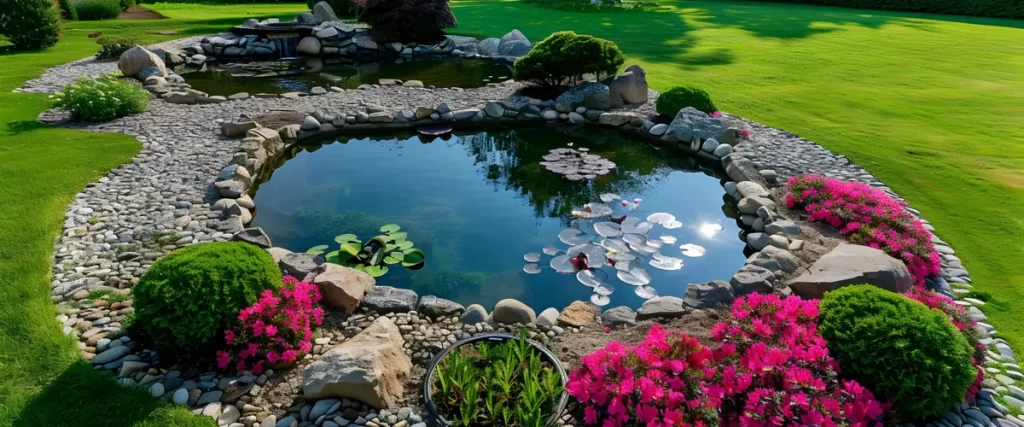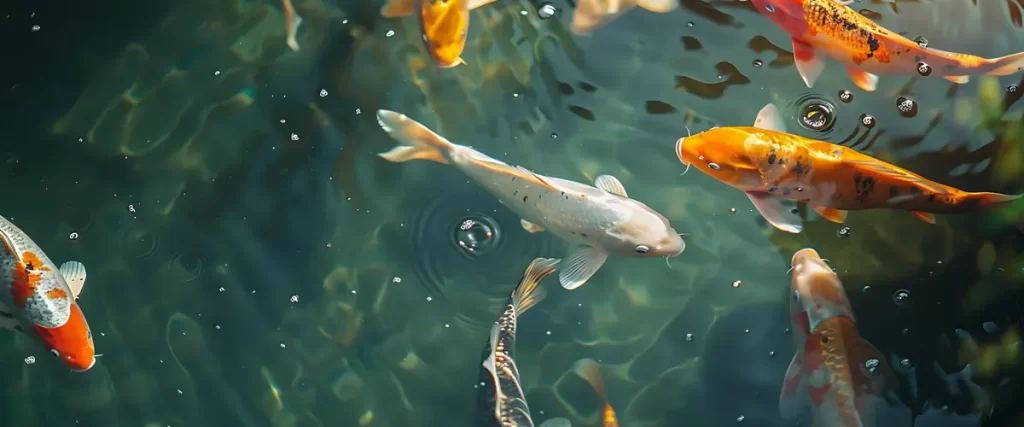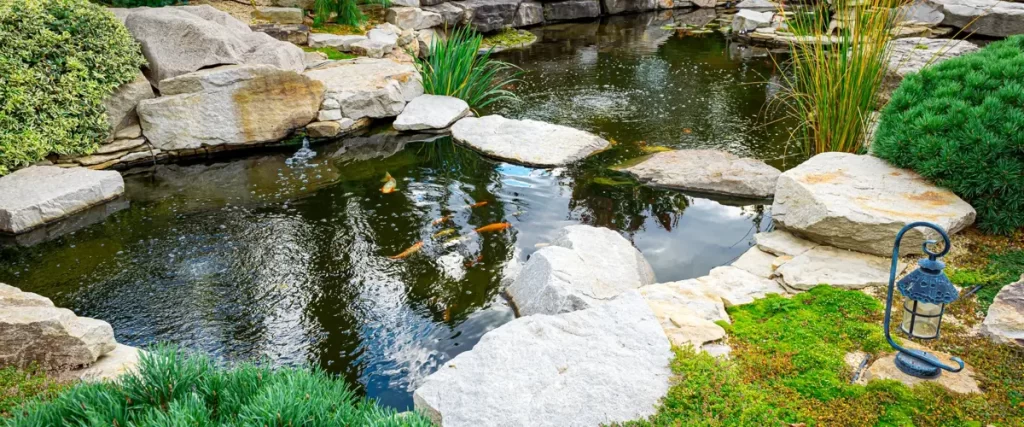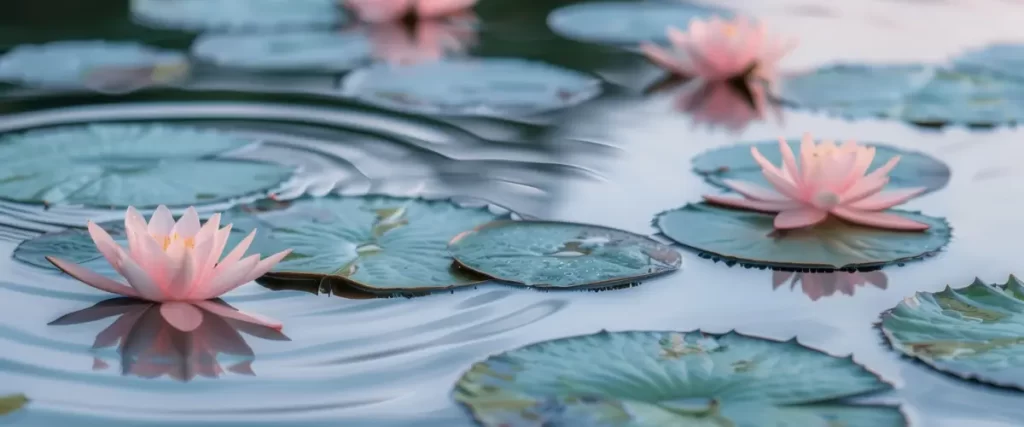Let’s talk about ponds. They’re peaceful, beautiful, and can make any backyard feel like a little getaway. But just like anything else, ponds can run into problems. And when they do, they let you know—it’s just a matter of knowing what to look for.
If you’ve got a pond and you’re wondering if it’s in good shape, this is for you. We’re going to talk about the most common signs that your pond might need some repairs and what you can do about it. Let’s jump in!

1. The Water Level Keeps Dropping
If you’re noticing that your pond water is going down faster than it should, that’s a big red flag. Sure, some water loss is normal because of evaporation, especially in hot weather. But if the water level keeps dropping even when it’s cool, you might have a leak.
What to Check:
- Look around the edges for wet spots.
- Check if any of the rocks or liners have shifted out of place.
- Inspect the liner for any visible holes or tears.
What to Do:
You might need to patch up the liner or even replace it if the damage is bad. If you’re not sure where the leak is, it might be time to call in a pro to help find and fix it.
2. The Water Looks Murky or Dirty
A healthy pond should look clear—or at least clear enough that you can see the bottom if it’s shallow. If your pond water looks murky, brown, or green, it’s usually a sign of an imbalance.
What Causes It:
- Too much algae.
- Buildup of debris like leaves or dirt.
- Issues with the filter or pump.
What to Do:
Start by cleaning out any visible debris. Then check your filter to make sure it’s working properly. If you’re still seeing murky water, you may need to install better filtration or add plants that help keep the water clean.
3. Fish Are Acting Weird or Dying
If you’ve got fish in your pond, they’re often the first to let you know something’s wrong. Healthy fish should swim around and seem lively. If they’re floating at the surface, gasping for air, or acting sluggish, that’s a warning sign.
What to Check:
- Water quality. Test for things like pH, ammonia, and oxygen levels.
- Temperature. Hot weather can cause oxygen levels to drop.
- Pump or aerator. Make sure they’re working to circulate the water.
What to Do:
You might need to add an aerator or change out some of the water to balance things out. And if your fish keep struggling, it’s worth getting an expert to test the water and figure out what’s going on.

4. Weird Smells Coming From the Pond
Does your pond smell bad? That’s not normal. A healthy pond might have a slight earthy smell, but if it starts to smell rotten or like sewage, there’s a problem.
What Causes It:
- Decaying plants or dead fish.
- Too much algae breaking down.
- Poor water circulation.
What to Do:
Clean out any dead leaves, plants, or fish. Make sure the pump is moving water properly, and consider adding beneficial bacteria to break down waste naturally.
5. Algae Is Taking Over
A little bit of algae isn’t a big deal, but if it starts taking over your pond, it can cause all kinds of problems. Too much algae blocks sunlight, reduces oxygen, and can even clog your pumps. It’s one of the most common pond problems in Florida.
What Causes It:
- Too many nutrients from fish food or fertilizer runoff.
- Not enough plants to compete with the algae.
- Poor water circulation.
What to Do:
You can physically remove algae, but it’s also important to fix the root cause. Add more plants to absorb excess nutrients, reduce feeding, and make sure your pump is working.
6. Pumps or Filters Aren’t Working Right
Your pond relies on pumps and filters to keep the water clean and oxygenated. If they stop working, the water can go bad fast.
What to Look For:
- Strange noises coming from the pump.
- Weak water flow.
- Filters clogged with debris.
What to Do:
Clean the filters and make sure the pump isn’t clogged. If it still isn’t working, it might need repairs or a replacement.
7. Plants Aren’t Thriving
Pond plants are great for keeping the water balanced and adding beauty. But if your plants start to turn yellow, rot, or die, it could mean your pond needs attention.
What Causes It:
- Poor water quality.
- Not enough sunlight.
- Nutrient imbalances.
What to Do:
Test the water to make sure the pH and nutrient levels are right. Trim back any dead parts of the plants, and consider adding fertilizer made for pond plants.
8. Visible Cracks or Damage
Sometimes the problem isn’t hidden—it’s right there for you to see. Cracks in concrete ponds or damage to liners can lead to leaks and other issues.
What to Look For:
- Cracks in concrete or stone borders.
- Tears in rubber or plastic liners.
- Loose rocks or shifted edges.
What to Do:
Small cracks might be fixable with sealant, but bigger ones might need help from a professional pond repairer. If the liner is damaged, you might need to replace it.
9. Waterfalls or Fountains Aren’t Flowing Right
If your pond has a waterfall or fountain, it should flow smoothly. If it’s sputtering, spraying unevenly, or not working at all, something’s up.
What to Check:
- Pump connections and hoses for clogs or leaks.
- Water levels—low water might make it hard for the pump to work.
- Debris blocking the flow.
What to Do:
Clean out any debris and check the pump. If it still doesn’t work, you might need a new pump or professional repairs.
10. Edges Are Eroding
Over time, the edges of your pond can wear down, especially if there’s a lot of rain or runoff. This can make your pond look messy and might even lead to leaks.
What to Look For:
- Muddy or loose soil around the edges.
- Rocks or liners shifting out of place.
- Plants falling into the pond.
What to Do:
Add rocks or edging materials to reinforce the borders, and make sure drainage is set up to keep water from washing out the soil.
11. Water Is Cloudy or Discolored
If your pond water looks cloudy, green, or brown, it’s trying to tell you something’s wrong.
What Causes It:
- Dirt or debris stirred up from the bottom.
- Algae blooms caused by too many nutrients in the water.
- Fish waste or decaying leaves breaking down.
What to Do:
Start by skimming out any visible debris. Then, clean or replace your filter if it’s clogged. Adding aquatic pond plants or beneficial bacteria can also help balance the water and prevent algae.

12. Strange Noises from Pumps or Equipment
If you hear rattling, grinding, or buzzing noises coming from your pump or filter, don’t ignore it. Those sounds often mean parts are loose, worn out, or clogged.
What to Check:
- Look for debris blocking the pump.
- Check hoses for leaks or cracks.
- Make sure parts like impellers or seals aren’t worn out.
What to Do:
Clean out any blockages and replace damaged parts. If the pump still doesn’t work right, it may be time for a new one.
13. Insects or Pests Taking Over
If your pond suddenly has swarms of mosquitoes or other pests, there might be stagnant water or a lack of circulation.
What Causes It:
- Broken pumps leading to still water.
- Buildup of organic debris where insects can lay eggs.
- Overgrowth of algae attracting bugs.
What to Do:
Clean up the pond, get the water moving again, and add mosquito fish if the problem continues. A well-maintained pond won’t attract pests.
14. Foamy Water
Foam floating on the surface can be a sign of too many organic materials, like fish waste, fertilizer runoff, or uneaten food.
What to Check:
- Water quality and pH levels.
- Filters and pumps to make sure they’re working properly.
- Overfeeding or fertilizer use near the pond.
What to Do:
Cut back on feeding, clean filters, and add beneficial bacteria to help break down organic materials.
15. Water Feels Slimy or Oily
If the water feels greasy or slimy, there may be oils from fish food, sunscreen, or fertilizers contaminating it.
What Causes It:
- Overfeeding fish.
- Fertilizer runoff from nearby plants.
- Sunscreen or oils washing in when people clean the pond.
What to Do:
Skim off the oily layer and test the water quality. Adding plants and bacteria can help break down oils naturally.
FAQs About Pond Repairs
1. How often should I check my pond for repairs?
You should check your pond regularly, at least once a month. Look for signs like water loss, dirty water, or broken equipment.
2. How do I know if I have a leak?
If your water level keeps dropping even when it’s cool outside, you likely have a leak. Check the liner, edges, and connections for damage.
3. How much does it cost to repair a pond?
Repairs can range from $200 for minor fixes to over $1,000 for larger problems like replacing liners or pumps.
4. Can I fix my pond myself?
Small repairs, like cleaning filters or patching liners, can be DIY projects. For bigger problems, it’s usually better to hire a pro.
5. What’s the best way to prevent future repairs?
Regular cleaning, checking equipment, and keeping water balanced can help avoid costly repairs down the road.

Keep Your Pond Healthy and Beautiful
Your pond should be a peaceful, relaxing part of your yard – not a source of stress. If you’ve noticed any of these signs, it might be time to give your pond the attention it needs. From fixing leaks to upgrading pumps and filters, regular maintenance can save you time and money in the long run.
At Site Pros Landscaping, we’re here to help you keep your pond looking and working its best. Whether you need repairs, upgrades, or a complete makeover, we’ve got the skills and experience to get the job done right.
Call us today at (407) 480-0713 and let’s bring your pond back to life!
You can also get in touch today, and let’s upgrade your space!
